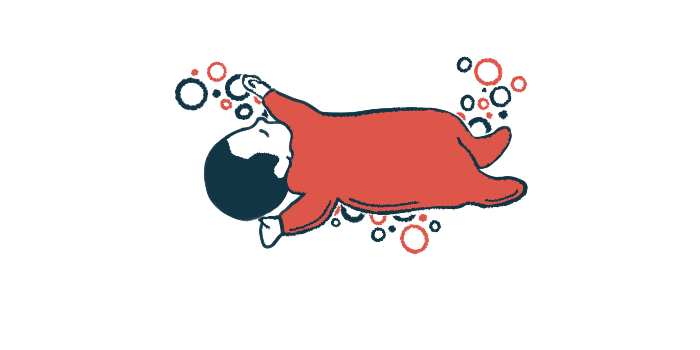Children’s Breathing Problems at Night Tied to Zolgensma Use


Despite its well-reported benefits in motor function, the gene therapy Zolgensma (onasemnogene abeparvovec-xioi) may not be as effective at preventing or easing breathing problems at night in young children with spinal muscular atrophy (SMA), according to a small real-world study.
Nighttime breathing problems were found to occur in all eight children in the study, regardless of age at diagnosis, age at receiving Zolgensma, or motor function scores at the time of treatment — a finding that “provides an initial insight into the magnitude of the condition,” the researchers noted.
“This study is the first to report polysomnography [sleep study] findings in children with SMA after [Zolgensma],” the team wrote.
The observed breathing difficulties highlight the need to screen young SMA patients via standardized polysomnography, they noted.
The study, “Polysomnography findings in children with spinal muscular atrophy after onasemnogene-abeparvovec,” was published in the journal Sleep Medicine.
Breathing problems likely to occur at night
In addition to motor problems, the progressive muscle weakness that characterizes SMA can cause breathing difficulties. When such problems occur at night, during sleep, the condition is referred to as sleep-disordered breathing (SDB). It’s been reported in untreated patients with all types of SMA.
Novartis’ Zolgensma is a one-time gene therapy approved in the U.S. for SMA newborns and toddlers up to age 2. The treatment is designed to increase the levels of SMN, a protein critical for the health of the specialized nerve cells that control voluntary movement and that is missing in SMA.
While Zolgensma has been shown to improve motor function in SMA patients, its effect on sleep-disordered breathing has not yet been assessed.
Now, a team at the University of Florida evaluated the nighttime breathing patterns of eight young children with SMA — four boys and four girls — after Zolgensma treatment.
The children were followed at the university’s center for neuromuscular and rare diseases, and were a median of 11.5 days of age (range, 5 days to 250 days, or about 8 months) when they were diagnosed with SMA. They were assessed here using a type of sleep study called polysomnography, which uses electroencephalography (EEG) and other measures.
Based on their genetic data, five of the children were likely to develop SMA type 1, a severe form, while two were likely to have type 2 disease. One had a high chance of developing the milder types 3 or 4.
Five of the children were already showing symptoms at the time of treatment initiation, which occurred at a median age of 46.5 days (range 20–257 days).
Before Zolgensma, one child had received the approved SMA oral daily medication Evrysdi (risdiplam) for one month, while another was treated with four doses of Spinraza (nusinersen), which was the first disease-modifying therapy approved for SMA.
The time between Zolgensma treatment and the subsequent polysomnography ranged from one to 13.3 months (about one year). Based on their clinician’s recommendation, two children were on nighttime non-invasive breathing support at the time of the sleep study.
100% of patients experience problems
Polysomnography revealed that all eight children had sleep-disordered breathing, as assessed by the apnea-hypopnea index (AHI) — the combined average number of apneas (breathing stoppages) and hypopneas (shallow breathing) that occur per hour of sleep. Total AHI values ranged from 3.4 to 24.1 per hour, all above the normal range of 1 or less for children.
Among all eight children, AHI values were higher during rapid eye movement (REM) sleep, which is associated with dreaming, compared with non-REM sleep.
Breathing stoppages caused by improper brain signals, called central sleep apnea, occurred more often than obstructive sleep apnea, which is caused by relaxed throat muscles that block the airways.
Six children had an AHI value of five or higher, and four had five or more central apnea events per hour or sleep. None, however, had five or more obstructive events per hour while asleep.
“In addition, none of the children presented with solely obstructive events,” the team wrote.
When breathing only room air during sleep, the oxygen levels in the children’s blood, measured by percent oxygen saturation, ranged between 78–90%, all below the normal value of 95%.
Motor skills, evaluated through the CHOP-INTEND score within a month of the sleep study, were not significantly associated with AHI values, “suggesting neuromotor evaluation does not aid in the identification of SDB,” the researchers wrote.
In addition, no significant links were found between AHI values and both age at diagnosis and age at treatment, between AHI during REM and time since treatment, and between the average drop in oxygen level per hour and both age at treatment and time since treatment.
The presence of SDB in all of the eight children, regardless of early diagnosis and treatment, “highlights the importance of screening with a standardized [polysomnography] in these patients,” the researchers wrote.
“SDB should be investigated in all children with SMA as early identification of SDB can also influence the decision to pursue additional disease-modifying therapies,” they added.
The team also noted that the inconsistent timing of polysomnography after Zolgensma was a study limitation.
As such, this work “highlights the need for guidelines regarding the need or timing of PSG [polysomnography] after therapies, as well as the PSG parameters that are clinically relevant for the monitoring and long-term management of SMA,” they concluded.
The post Children’s Breathing Problems at Night Tied to Zolgensma Use appeared first on SMA News Today.



